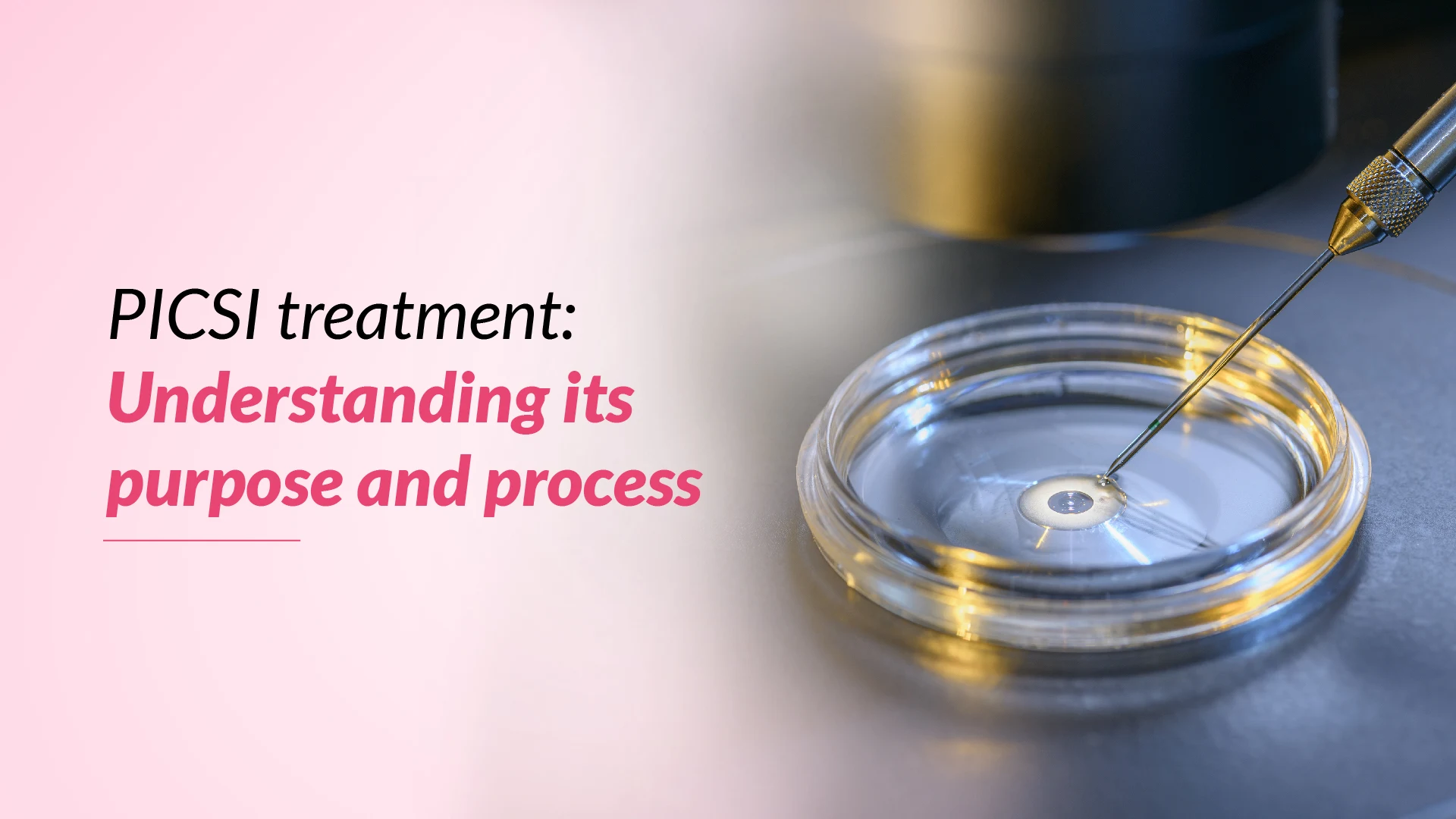In the field of assisted reproductive technologies (ART), the quest for enhancing fertility outcomes has led to the development of innovative techniques. One such advancement is the PICSI (Physiological Intracytoplasmic Sperm Injection) procedure, which aims to improve the selection of high-quality sperm for fertilisation. As couples navigate this difficult journey of overcoming infertility, understanding the purpose and process of PICSI can provide valuable insights and hope for a successful outcome.
What is PICSI?
PICSI, short for Physiological Intracytoplasmic Sperm Injection, is an advanced sperm selection technique used in conjunction with in vitro fertilisation (IVF) and intracytoplasmic sperm injection (ICSI). It involves using a specialised dish coated with hyaluronan, a natural compound found in the female reproductive tract. The dish mimics the conditions sperm encounters during the natural fertilisation process, allowing for the identification and selection of the most viable and mature sperm cells.
What is the Difference Between ICSI and PICSI
While ICSI (Intracytoplasmic Sperm Injection) involves injecting a single sperm cell into an egg, PICSI takes this process a step further by integrating a layer of physiological assessment in addition to morphology (shape) and motility (movement).
The PICSI dish is coated with hyaluronan, a substance found in the female reproductive tract that plays a crucial role in the natural sperm selection process. Only mature sperm with the ability to bind to hyaluronan are considered for the ICSI procedure. This binding ability is an indicator of the sperm’s maturity and its potential to fertilise the egg successfully.
By selecting sperm based on their physiological characteristics, PICSI aims to improve the chances of successful fertilisation and embryo development, ultimately increasing the likelihood of a successful pregnancy.
What is the Purpose of the PICSI Procedure
The PICSI procedure helps address various challenges faced in assisted reproductive treatments and aims to achieve the following objectives:
Enhancing Sperm Selection
The primary purpose of PICSI is to enhance the selection of high-quality sperm for fertilisation. By mimicking the natural environment of the female reproductive tract, PICSI enables the identification of sperm cells with the ability to bind to hyaluronan, a crucial step in the fertilisation process. This selection method increases the chances of using the most viable and mature sperm for fertilisation.
Improving Fertilisation Rates
By selecting sperm that exhibit physiological markers of maturity and fertilisation potential, PICSI aims to improve the overall fertilisation rates in IVF and ICSI cycles. Higher fertilisation rates can lead to an increased number of viable embryos for transfer or cryopreservation, potentially enhancing the chances of a successful pregnancy.
Reducing Genetic Abnormalities
Some studies suggest that the PICSI method may help reduce the possibility of genetic abnormalities in embryos by selecting sperm with intact DNA and well-developed cellular structures. This could lower the incidence of chromosomal disorders and other genetic conditions in the resulting offspring.
Benefiting Male Factor Infertility
PICSI can be particularly beneficial for couples dealing with male factor infertility, where the quantity or quality of sperm is compromised. By selecting the most viable sperm, PICSI may improve the chances of successful fertilisation and embryo development in cases of severe male factor infertility.
Increasing IVF Success Rates
By optimising sperm selection and improving fertilisation rates, PICSI aims to increase the overall success rates of IVF and ICSI treatments. Higher-quality embryos resulting from the PICSI procedure may lead to enhanced implantation rates and higher chances of achieving a successful pregnancy.
Providing Hope for Previous IVF Failures
For couples who have encountered multiple failed IVF cycles, PICSI can offer a renewed sense of hope. By addressing potential issues related to sperm quality and selection, PICSI may increase the chances of success in subsequent IVF attempts.
Lowering the Risk of Miscarriage
Some studies suggest that the use of PICSI may help reduce the risk of miscarriage by selecting sperm with a higher likelihood of producing genetically normal embryos. However, more research is needed to confirm this potential benefit conclusively.
Enhancing Embryo Quality
By selecting sperm with superior physiological characteristics, PICSI aims to contribute to developing high-quality embryos. Improved embryo quality can increase the chances of successful implantation and ongoing pregnancy.
PICSI Procedure Step-by-step
The PICSI procedure involves several steps, each designed to optimise the selection and utilisation of high-quality sperm for fertilisation.
Sperm Selection
- Semen Sample Collection: The process begins with collecting a semen sample from the male partner.
- Sperm Preparation: The semen sample undergoes standard preparation techniques, such as density gradient centrifugation, to separate the motile sperm from other cellular components.
- PICSI Dish Preparation: A specialised dish is coated with hyaluronan, mimicking the natural environment of the female reproductive tract.
- Sperm Incubation: The prepared sperm sample is incubated in the PICSI dish, allowing the mature sperm to bind to the hyaluronan coating.
- Sperm Selection: After incubation, the sperm bound to the hyaluronan coating is carefully identified and selected for the ICSI procedure.
Intracytoplasmic Sperm Injection
- Egg Retrieval: Doctors retrieved mature eggs from the female partner through a minor surgical procedure.
- Sperm Injection: Using a specialised microscope and micromanipulation tools, doctors inject these selected sperm from the PICSI dish directly into the cytoplasm of the mature eggs, a process known as intracytoplasmic sperm injection (ICSI).
Embryo Development
- Fertilisation: After the ICSI procedure, the fertilised eggs (zygotes) are carefully monitored for signs of normal embryonic development.
- Embryo Culture: The developing embryos are cultured in a controlled laboratory environment, allowing them to grow and divide into multiple cells.
- Embryo Selection: Doctors select the most viable embryos for transfer or cryopreservation based on established criteria, such as cell division rate and morphological characteristics.
Embryo Transfer
- Preparation for Transfer: The selected embryos are prepared for transfer into the woman’s uterus.
- Embryo Transfer Procedure: In a minimally invasive procedure, the embryos are carefully transferred into the uterus of the female patient, where they have the potential to implant and develop into a successful pregnancy.
Who Can Benefit from PICSI?
The PICSI procedure can be beneficial for various groups of couples facing fertility challenges, including:
Couples with Previous IVF Failures
For couples who have had multiple failed IVF cycles, PICSI can offer a renewed opportunity for success. By optimising sperm selection and improving the chances of fertilisation and embryo development, PICSI may increase the possibility of a successful pregnancy in subsequent attempts.
Male Factor Infertility
PICSI can be particularly advantageous for couples dealing with male factor infertility, where the sperm’s quality or quantity is compromised. By selecting the most viable sperm, PICSI may improve the chances of successful fertilisation and embryo development, even in cases of severe male factor infertility.
Unexplained Infertility
In instances of unexplained infertility, where the cause remains unclear, PICSI can be a valuable option. By enhancing sperm selection and potentially improving fertilisation rates, PICSI may increase the chances of achieving a successful pregnancy for couples with unexplained infertility.
Find Hope and Solutions for Female Infertility and Male Infertility — Explore Our Comprehensive Services
IUI Treatment
Fertility Preservation Service
Blastocyst Culture & Transfer Treatment
Conclusion
The PICSI procedure represents a significant advancement in the field of assisted reproductive technologies. By mimicking the natural sperm selection process and identifying the most viable and mature sperm, PICSI aims to improve fertilisation rates, embryo quality, and, ultimately, the chances of a successful pregnancy. As couples navigate the complex journey of overcoming infertility, PICSI offers a promising option, providing hope and potentially increasing the likelihood of achieving the dream of parenthood.




























